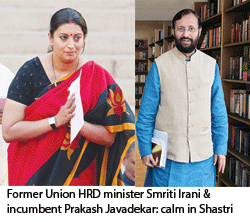 In a year marked by controversies and agitations on university campuses countrywide, the critical issue of preschool, school and higher education reform was neglected by the ruling BJP/NDA and state governments - Summiya Yasmeen
In a year marked by controversies and agitations on university campuses countrywide, the critical issue of preschool, school and higher education reform was neglected by the ruling BJP/NDA and state governments - Summiya Yasmeen
2016 was a status quo year for Indian education. In a 12-month interregnum marked by inconsequential controversies and agitations on university campuses countrywide, the critical issue of preschool, school and higher education reform was neglected by the ruling BJP/NDA and state governments countrywide.
The biggest education promise made by the Narendra Modi government of enacting a National Education Policy (NEP), 2016 — three decades after the National Policy on Education 1986 was promulgated — came to nought with the Union human resource development (HRD) ministry side-stepping the inconvenient recommendations of the five-member T.S.R. Subramanian Committee for Evolution of the National Policy on Education 2016. The constructive 217-page Subramanian Committee Report, which forthrightly calls for the Central government to revise its financial priorities and raise annual expenditure (Centre plus states) to 6 percent of GDP “without any further delay”, and confer full autonomy upon higher education institutions (anathema to the Rashtriya Swayamsevak Sangh (RSS) — the acknowledged ideological parent organisation of the BJP), has in effect been shelved. Union HRD minister Prakash Javadekar has since expressed the intent to constitute another more amenable committee to submit a new NEP 2016 policy draft.
Yet the highlight of the recently concluded year was the ouster in July of BJP fire-brand Smriti Irani from Shastri Bhavan, Delhi, headquarters of the Union HRD ministry. During her two-year tenure, Irani hit headlines for reckless interference with the administration and autonomy of the country’s few centres of higher ed excellence, rather than for constructive reform initiatives. In a sudden cabinet reshuffle in July, Irani was shunted to the Union textiles ministry and Prakash Javadekar, hitherto Union minister of state for environment, forests and climate change in the Narendra Modi-led government, was promoted to Shastri Bhavan.
Although relative calm has returned in the HRD ministry after Irani’s transfer, little progress has been made on the issue of overdue reforms in the country’s fast-obsolescing education sector across the spectrum. On the contrary, toeing the RSS line Javadekar dismissed the Subramanian Committee Report as “just another input” for framing NEP 2016, and has reportedly shortlisted more malleable members of a new committee to prepare a new policy draft.
However on the credit side, under Javadekar’s leadership the HRD ministry has reworked Irani’s controversial IIM Bill, 2015, which proposed to drastically dilute the academic and financial autonomy of the Indian Institutes of Management (IIMs), to confer greater autonomy on these globally respected B-schools promoted and subsidised by the Central government. Moreover the HRD ministry has finalised an amendment to s.16 of the Right of Children to Free and Compulsory Education Act (aka RTE Act), 2009, to remove the no-detention of children in elementary education (classes I-VIII) provision. The general consensus among educationists was that this well-intentioned provision had depressed learning outcomes of children countrywide. In late October, the ministry also announced that the class X exams for affiliated schools of the Central Board of Secondary Education (CBSE) — India’s largest national school-leaving examinations board supervised by the HRD ministry (see p. 16) — will be reintroduced from the academic year 2017-18.
Meanwhile as the country’s politicians and educrats at the Centre and in the states continue to neglect critical root and branch reforms in education, India’s academic reputation is sliding. According to Unesco’s Global Education Monitoring report, released last September, the country will achieve its universal primary education goal in 2050 instead by 2020; universal lower secondary education goal in 2060 and universal higher secondary education in 2085.
In higher education too, the picture is dismal. None of India’s 800 universities are ranked in the Times Higher Education (THE) Top 200 World University Rankings 2016, and India is the only country without a university in the Top 10 table of THE’s BRICS (Brazil, Russia, India, China and South Africa) & Emerging Economies Rankings 2016 (see p. 75).
In the following pages, managing editor Summiya Yasmeen summarises the education landmarks of 2016. (EducationWorld’s more detailed coverage of almost all milestone events of 2016 noted below can be accessed at www.educationworld.in Archives).
Dalit student suicide outrage
January 17. Rohith Vemula (26), a Ph D scholar at the University of Hyderabad (UoH), hanged himself to death in a hostel room at the university. This young scholar claimed he had been subjected to humiliating discrimination in this Central government-funded and administered university because of his Dalit caste credentials.
Earlier, Vemula and four other Dalit students had been “partially suspended” from UoH — permitted to attend classes but expelled from the hostel and deprived of their Rs.25,000 monthly scholarship stipends — for allegedly assaulting several office-bearers of ABVP (Akhil Bharatiya Vidyarthi Parishad), the student wing of the ruling BJP at the Centre. Although a university committee exonerated the Dalit students of assault charges, Hyderabad-based BJP Union minister of state for labour Bandaru Dattatreya persuaded the Union HRD ministry to write five letters to the vice chancellor of UoH, resulting in the partial suspension of the Dalit students for “casteist and anti-national” activities.
Following a nationwide outcry, on January 28 Union HRD minister Smriti Irani ordered a single-judge commission to “investigate the sequence of events and the circumstances leading to the suicide” and “enquire if the university followed University Grants Commission 2012 resolution on discrimination”. (Education News, EW February).
TN CBSE/CISCE schools get reprieve
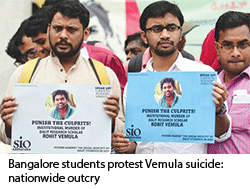 January 28. The Supreme Court passed an interim order restraining the Justice S.R. Singaravelu Private Schools Fee Determination Committee (PSFDC) from interfering with tuition fees levied by schools in Tamil Nadu affiliated with the Delhi-based CBSE and CISCE exam boards. The apex court’s order limited the powers of PSFDC to verifying if tuition fees levied by the state’s 580 CBSE and 52 CISCE schools are commensurate with the facilities provided by them, hearing complaints and recommending disaffiliation of schools charging exorbitant fees.
January 28. The Supreme Court passed an interim order restraining the Justice S.R. Singaravelu Private Schools Fee Determination Committee (PSFDC) from interfering with tuition fees levied by schools in Tamil Nadu affiliated with the Delhi-based CBSE and CISCE exam boards. The apex court’s order limited the powers of PSFDC to verifying if tuition fees levied by the state’s 580 CBSE and 52 CISCE schools are commensurate with the facilities provided by them, hearing complaints and recommending disaffiliation of schools charging exorbitant fees.
The interim order ended a three-year struggle by CBSE and CISCE schools for exemption from the ambit of the Tamil Nadu Schools Regulation of Collection of Fee Act, 2009, enacted by the former DMK government (2006-2011). In February 2013, the state’s Association of Managements of Private Schools (CBSE) challenged the Act in the Supreme Court.
The apex court’s ruling was widely welcomed by CBSE/CISCE school managements in the state which were struggling to meet expenses as the tuition fees prescribed by the PSFDC were inadequate to provide quality education. (Education News, EW April)
Delhi high court reinstates management quota
February 16. The Delhi high court restored the 20 percent management quota of 6,600 private unaided composite schools offering pre-primary education in the national capital. In its order, the court upheld the school managements/promoters’ right to allocate 20 percent of pre-primary/nursery seats at their discretion.
Earlier on January 6, the AAP government of Delhi state had abolished the management quota citing widespread complaints that composite school managements were demanding upfront ‘capitation fees’ for nursery admissions. Although chief minister Arvind Kejriwal described the management quota as the “biggest scam in education today,” the Delhi high court upheld a stay order against abolition of the management quota.
This verdict came as a huge victory for private composite school managements, and a setback for the Kejriwal-led AAP government of Delhi state. (Education News, EW March)
JNU students union president arrested
February 12. Kanhaiya Kumar, president of the students union of the top-ranked Jawaharlal Nehru University (JNU), was arrested on sedition charges by the Central government-controlled Delhi police. Kumar was accused of raising “anti-national” slogans at a protest rally in JNU to mark the third anniversary of the execution of Kashmiri terrorist Afzal Guru, sentenced to death by the Supreme Court after an exhaustive set of trials and appeals in 2005. Five days later when Kumar was produced in Delhi’s Patiala House court, some professedly nationalist lawyers assaulted Kumar, journalists, some JNU faculty and students. However, the BJP government, in charge of law and order in the national capital, failed to arrest any of the unruly lawyers, although they were clearly identified by print and television media.
Kumar’s arrest triggered student and faculty protests in JNU and university campuses countrywide against the BJP/NDA government for supressing freedom of speech and expression. (Editorial, EW March).
Union Budget neglects education again
 February 29. Union finance minister Arun Jaitley presented the second full-fledged budget of the Narendra Modi-led BJP/NDA government to Parliament. Though in his 101-minute budget speech, Jaitley included “education, skills and job creation to make India a knowledge-based and productive society” among his “nine pillars to transform India”, the Central government ritually increased its education outlay for 2016-17 to Rs.72,394 crore — a mere 3.24 percent increase over the actual expenditure of Rs.67,586 crore in 2015-16, which itself was revised downwards from the Rs.82,771 crore budgeted for the year. As a percentage of GDP too, the Union government’s education outlay in Budget 2016-17 is 0.48 percent cf. 0.50 in 2015-16 and 0.66 in 2012-13.
February 29. Union finance minister Arun Jaitley presented the second full-fledged budget of the Narendra Modi-led BJP/NDA government to Parliament. Though in his 101-minute budget speech, Jaitley included “education, skills and job creation to make India a knowledge-based and productive society” among his “nine pillars to transform India”, the Central government ritually increased its education outlay for 2016-17 to Rs.72,394 crore — a mere 3.24 percent increase over the actual expenditure of Rs.67,586 crore in 2015-16, which itself was revised downwards from the Rs.82,771 crore budgeted for the year. As a percentage of GDP too, the Union government’s education outlay in Budget 2016-17 is 0.48 percent cf. 0.50 in 2015-16 and 0.66 in 2012-13.
Among the crumbs Jaitley offered to the world’s largest (500 million) child and youth population in Budget 2016-17: the Sarva Shiksha Abhiyan (‘Education for All’) primary education programme promised an unspecified “increasing share of allocation”; 62 new Central government-funded Navodaya Vidyalayas (co-ed rural boarding schools) over the next two years; Rs.1,000 crore for establishment of a Higher Education Funding Agency (HEFA) for improving the infrastructure of top-ranked universities; promotion of 1,500 Multi-skill Training Institutes at a cost of Rs.1,700 crore, and entrepreneurship education and training in schools, colleges and government ITIs through Moocs (massive open online courses). (Special Report, EW April)
RTE s. 12(1)(c) dismal compliance report
March 10. The State of the Nation: RTE s.12 (1) (c) Report, a collaborative study published by the RTE Resource Centre of IIM-Ahmedabad, Central Square Foundation, Accountability Initiative (Centre for Policy Research) and Vidhi Centre for Legal Policy, was released in Delhi.
According to the report, of the estimated 2.28 million seats countrywide in classes I-VIII of non-minority private unaided (independent) day schools, reserved by law for children from poor households in their neighbourhoods under s.12 (1) (c) of the Right of Children to Free and Compulsory Education (RTE) Act, 2009, only 346,108 (15 percent) were filled in the academic year 2014-15. The most s.12 (1) (c)-compliant states are Delhi (44.61 percent), Rajasthan (39.26 percent), Tamil Nadu (37.75), Chhattisgarh (32.94) and Uttarakhand (31.96 percent). States with less than 1 percent compliance are Andhra Pradesh (nil), Telangana (0.01 percent), Mizoram (0.21), Uttar Pradesh (0.79) and Odisha (0.97 percent). (Education News, EW April)
National Achievement Survey
March 16. The Delhi-based National Council of Educational Research & Training (NCERT) released its first-ever National Achievement Survey (NAS) 2015, which measured the learning outcomes of a sample 277,416 class X students of 7,216 schools affiliated with two national and 31 state examination boards countrywide. The randomly selected class X students were administered standardised tests in five subjects (English, maths, science, social science and the dominant state language) by NCERT.
In this survey, students of private unaided schools affiliated with the Delhi-based Council for the Indian School Certificate Examinations (CISCE) recorded the highest aggregate score, followed by students of the Central Board of Secondary Education (CBSE). However the survey found that the average national score of all the 2.70 lakh children was a disappointing less than 50 percent in all the five subjects tested. (Cover story, EW June)
AAP’s illusory education bonanza
March 29. For the second year in a row, the Aam Aadmi Party (AAP) — which was swept to power in the Delhi state legislative assembly in 2015 — tabled an education-focused Budget 2016-17. Deputy chief minister Manish Sisodia, also the finance and education minister, announced an outlay of Rs.10,690 crore for education, equivalent to 23 percent of the Rs.46,000 crore annual budget of Delhi state.
However, though the education outlay for 2016-17 was 8.6 percent higher than the previous year’s Rs.9,836 crore and the highest in the history of Delhi state, educationists and academics pointed out that adjusted for inflation, the proposed outlay wasn’t as impressive. Moreover the 236 new schools promised to be promoted by the end of fiscal 2015-16, not even one was operational with a mere 25 under construction. And the 50 model schools announced by the government in its maiden 2015 budget, are yet to be constructed. All Delhi government colleges were to be wi-fi enabled, which still remains a promissory note. (Education News, EW April)
National Institutional Ranking Framework
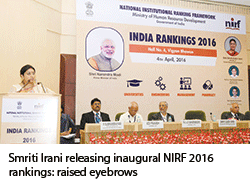 April 4. The first official (Union HRD ministry) league tables ranking the Top 100 category ‘A’ Indian universities, engineering colleges and B-schools were released in New Delhi. Based on a National Institutional Ranking Framework (NIRF) devised by a 16-member “core committee” of academics selected by the HRD ministry in October 2014, the first-ever government league tables evaluated category ‘A’ higher education institutions on six parameters, viz, teaching, learning and resources; research and professional practice; graduation outcomes; outreach and inclusivity; perception.
April 4. The first official (Union HRD ministry) league tables ranking the Top 100 category ‘A’ Indian universities, engineering colleges and B-schools were released in New Delhi. Based on a National Institutional Ranking Framework (NIRF) devised by a 16-member “core committee” of academics selected by the HRD ministry in October 2014, the first-ever government league tables evaluated category ‘A’ higher education institutions on six parameters, viz, teaching, learning and resources; research and professional practice; graduation outcomes; outreach and inclusivity; perception.
In this maiden official league table of India’s best universities, while the #1 rank was predictably awarded to the Indian Institute of Science, Bangalore, the ranking of Tezpur University (#4) above Delhi U prompted widespread criticism in academia. Ditto the rankings of Aligarh University (#10) and Viswa Bharati, Kolkata at #11.
In the engineering and B-school league tables, the select committee played it safe by ranking all IITs headed by IIT-Madras, and the IIMs headed by IIM-Bangalore, among the Top 10. However, the #19 rank of the newly promoted IIT-Mandi above the College of Engineering, Pune (estb.1848) and PSG College of Technology, Coimbatore aroused derision. Likewise, in the B-schools league table, the #15 rank of the Thiagarajar School of Management, Madurai, above the transnational S.P. Jain Institute of Management & Research (#16), Mumbai, and Vellore Institute of Management (#17) raised eyebrows among informed monitors of Indian higher education.
Responding to widespread criticism of its inaugural rankings, on April 25 the HRD ministry constituted a nine-member committee under the chairmanship of higher education secretary, V.S. Oberoi to review the ranking methodology and establish a permanent NIRF cell within the National Board of Accreditation. (Education News, EW May)
IITs fees hike
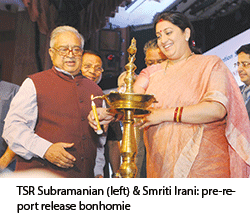 April 8. The Union HRD ministry raised the annual tuition fee for higher secondary school-leavers entering the country’s 23 Indian Institutes of Technology (IITs) from Rs.90,000 to Rs.200,000 from the academic year starting July.
April 8. The Union HRD ministry raised the annual tuition fee for higher secondary school-leavers entering the country’s 23 Indian Institutes of Technology (IITs) from Rs.90,000 to Rs.200,000 from the academic year starting July.
Although the IIT Council comprising representatives of 16 of the 23 IITs chaired by Union HRD minister Smriti Irani, initially approved the new tuition fee for all students, protests from students at IIT-Kharagpur prompted the ministry to issue a clarification that the new tuition fees will be applicable only to new batches of students entering these prized institutes. Moreover, the ministry’s clarification stated that students from the scheduled castes and scheduled tribes, the differently-abled and from households with annual incomes of less than Rs.100,000 will receive full tuition fee waiver. Students from households with annual incomes of less than Rs.500,000 will be entitled to a two-thirds tuition waiver while all others will be provided interest-free loans to fund their education.
Expectedly, while the student community strongly opposed the steep 121 percent increase in tuition fee, informed academics and industry representatives welcomed the fees hike as long overdue. (Education News, EW May)
Supreme Court makes NEET exam compulsory
April 11. Reversing its July 18, 2013 order against introduction of a National Eligibility-cum-Entrance Test (NEET) to determine admission into all medical colleges countrywide, the Supreme Court upheld a review petition of the Medical Council of India and reinstated NEET. Henceforth performance in this common entrance exam will determine admission into all public and private medical and dental colleges countrywide with an aggregate capacity of 52,000 undergraduate and 25,000 postgrad seats. By reversing its 2013 judgement and restoring NEET, the apex court invalidated an estimated 100 entrance exams of private medical college associations and also scrapped the medical/dental CETs (common entrance tests) conducted by state governments.
However with state governments protesting the abolition of their CETs on the grounds of federalism and states’ autonomy and arguing that most students had already written state CETs, on May 24, the BJP-led NDA government issued an ordinance giving state governments permission to conduct their CETs for the academic year 2016-17. (Education News, EW June)
EW Private Higher Education Rankings 2016
May 7. Manipal University was ranked India’s #1 private university; BITS-Pilani the #1 private engineering university and the Xavier School of Management, Jamshedpur the country’s #1 private B-school, in the inaugural EW Private Higher Education Rankings 2016 commissioned by EducationWorld, and conducted by the Delhi-based market research and opinion polling company, C fore.
Over 100 C fore field personnel polled a sample database of 8,131 well-informed individuals including 3,922 academics, 3,232 final year students and 977 managers in Indian industry, and persuaded them to rate the country’s Top 100 private universities, engineering colleges and B-schools across seven parameters of academic excellence. The scores awarded on a scale of 1-100 under each parameter by the sample respondents were totalled by C fore to rank institutions inter se in each category. (Cover story, EW May)
New Education Policy report storm
May 28. The report of a five-member committee chaired by former Union cabinet secretary T.S.R. Subramanian, constituted in October 2015 by the Union HRD ministry to draft a New Education Policy (NEP) 2016, was presented to HRD minister Smriti Irani.
However, the report quickly ran into a storm with Irani refusing to heed Subramanian’s demand to make the report available to the public for debate and discussion, on the ground that the report is “the property of 110,000 villages, over 5,000 blocks, over 500 districts, and 20 states, which have entrusted it to us with the confidence that any recommendation that comes to the Centre will be shared with them before it is made into a draft policy”. Unfazed, Subramanian called a press conference in Delhi on June 23 and suo motu released the 217-page report of the committee, which has made 90 recommendations for incorporation into NEP 2016.
Among the recommendations of the Subramanian Committee: Repeal of the no-detention until class VIII provision of the RTE Act, 2009 and introduction of examinations after class V; provision of early childhood education to all children in the four-six age group; introduction of vocational education from class VIII onwards; raising the annual outlay for education (Centre plus states) to 6 percent of GDP; granting greater financial and academic autonomy to higher education institutions, and allowing top-ranked foreign universities to establish campuses in India. (Education News, EW July and Cover Story, EW November)
Bihar exam toppers scam
June 1. The Bihar state government ordered a probe and re-examination of 13 students who topped the intermediate (class XII) arts and science exams conducted by the Bihar School Examinations Board (BSEB) after videos exposing the utter ignorance of the exam toppers went viral on social media. Transformed into celebrities and interviewed on social media, one of the students who bested 510,000 arts students to top the state board’s class XII school-leaving exam, described political science as “prodigal science” and opined that it’s about “cooking”.
The social media exposé unearthed a massive exams score-sheets manipulation racket in which students paid Rs.15 lakh-plus to top the school-leaving exam. This scandal prompted the resignation of Lalkeshwar Prasad Singh, chairman of BSEB and a police investigation of the top-ranked examinees. (Editorial, EW July)
Prakash Javadekar appointed HRD minister
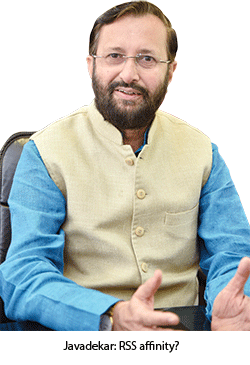 July 4. Following a minor Union cabinet reshuffle, Prakash Javadekar, former minister of state for environment, forest management and climate change, was promoted to the office of Union human resource development (HRD) minister of the BJP-NDA government at the Centre. His controversial predecessor in Shastri Bhavan, Smriti Irani, was moved to the Union textiles ministry.
July 4. Following a minor Union cabinet reshuffle, Prakash Javadekar, former minister of state for environment, forest management and climate change, was promoted to the office of Union human resource development (HRD) minister of the BJP-NDA government at the Centre. His controversial predecessor in Shastri Bhavan, Smriti Irani, was moved to the Union textiles ministry.
Within two weeks of taking charge as HRD minister, Javadekar met with top leaders of the Rashtriya Swayamsevak Sangh (RSS), the acknowledged ideological parent organisation of the BJP, and leaders of affiliated hindutva organisations such as Vidya Bharati, ABVP, Bharatiya Shikshan Mandal, Vigyan Bharati etc. His first public outing after assuming office was also to an event organised by the RSS-affiliated Bharatiya Shikshan Mandal to discuss the New Education Policy 2016. The general expectation is that like his predecessor Irani, Javadekar will continue to be heavily influenced by the RSS while discharging his duties as Union HRD minister. (Education News, EW August)
Parliament passes Child Labour Amendment Bill
July 26. The Lok Sabha passed the Child Labour (Prohibition and Regulation) Amendment Bill, 2016, which prohibits employment of children below 14 years of age in all occupations and enterprises, except family businesses. The Bill makes child labour a cognizable offence punishable by a jail term of up to three years and penalty of up to Rs.50,000, or both.
Though the Bill totally outlaws employment of children below 14 years and also mandates a rehabilitation fund for the education and welfare of children rescued from workplaces, the amendment to s.3 which permits children to work in “family enterprises” or “as an artist in an audio-visual entertainment industry”, has drawn criticism from child rights activists who argue that since 60 percent of households in the country are engaged in agriculture, farming can be classified as a family enterprise. The Bill’s proviso that children under 14 are permitted to help out with family businesses only after school hours was also criticised as unimplementable. (Education News, EW August)
IIM Bill 2015 recast
August 4. Union HRD minister Prakash Javadekar signed a new draft of the IIM Bill, 2015 after reaching agreement on several key points with the prime minister’s office (PMO) which had voiced reservations against the earlier draft’s interventionist and control provisions for management of the country’s premier business schools.
The new draft Bill provides that top appointments in IIMs will be made not by the President of India on the advice of the government as proposed in the previous draft, but by their board of governors. The new draft also provides that a coordination council for all IIMs comprising government representatives will make non-binding suggestions to the institutes. The earlier draft had made the coordination council’s decisions binding. These provisions were strongly criticised on grounds that they severely abridged the autonomy of the IIMs, including the globally respected ABC (Ahmedabad, Bangalore and Calcutta) institutes, whose graduates are snapped up by the world’s top-rated corporates. (Education News, EW November)
India 50 years behind on education goals
September 6. Unesco’s Global Education Monitoring (GEM) report was released in New Delhi. According to the report, India will be 50 years late in achieving the United Nations millennium development goal of universal primary education, and will achieve it only in 2050. Moreover, it is likely to universalise secondary education as late as 2060 and universal upper secondary education in 2085. The revised 2030 deadline for achieving the UN’s millennium development goals will be possible only if India introduces fundamental changes in the education sector, said the report.
According to the GEM report, 60 million children in India receive little or no formal education and 11.1 million lower secondary age children are out-of-school, the highest number worldwide. Similarly, 46.8 million higher secondary age children are out of school.
EW India School Rankings 2016
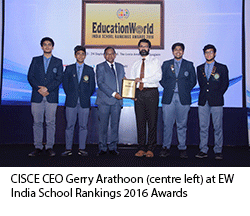 September 7. The Valley School, Bangalore (co-ed), Modern School, Barakhamba Road, Delhi (day-cum-boarding), J.B. Petit School for Girls, Mumbai (all-girls) and Campion School, Mumbai (all-boys) were ranked India’s most admired day schools in the ninth EducationWorld India School Rankings 2016.
September 7. The Valley School, Bangalore (co-ed), Modern School, Barakhamba Road, Delhi (day-cum-boarding), J.B. Petit School for Girls, Mumbai (all-girls) and Campion School, Mumbai (all-boys) were ranked India’s most admired day schools in the ninth EducationWorld India School Rankings 2016.
Rishi Valley School, Chittoor (co-ed), Welham Girls, Dehradun (all-girls), and The Doon School, Dehradun (all-boys) were ranked #1 in the traditional/legacy boarding schools category, while Dhirubhai Ambani International, Mumbai (day), Indus International, Bangalore (day-cum-boarding), and Woodstock School, Mussoorie and Good Shepherd International, Ooty were jointly voted the country’s #1 fully residential international schools. Moreover this year, separate tables of Top 10 government day and residential schools, special needs and budget private schools were included in the survey.
A total of 10,301 SEC (socio-economic category) ‘A’ fees-paying parents, teachers, principals and educationists in 28 cities countrywide were interviewed by 140 field researchers of the Delhi-based Centre for Forecasting & Research Pvt. Ltd (C fore) to rate and rank 1,000 of the country’s most well-known day, boarding and international primary-secondary schools. (Cover story, EW September)
Green light for photocopying
September 16. The Delhi high court ruled that photocopying of sections of prescribed reference and textbooks, even in the form of “course packs”, for the use of students does not violate the copyright of publishers.
The court dismissed a suit filed by publishing majors Oxford University Press, Cambridge University Press and Taylor & Francis, which sued Delhi University and Rameshwari Photocopying Services, a kiosk inside the Delhi School of Economics, for replicating reams of material from textbooks published by the plaintiffs and creating “course packs” mapped with college and university study programmes. The 94-page verdict ruled that photocopying and creation of course packs for the use of students is permitted by the Copyright Act, 1957.
Following the Delhi high court ruling, students and academics in India are exempt from global copyright norms which forbid extensive replication of legally published books. (Postscript, EW October)
CABE favours repealing no detention clause
October 26. A meeting of CABE (Central Advisory Board of Education) under the chairmanship of Union HRD minister Prakash Javadekar, advised the Central government to repeal s.16 of the Right of Children to Free and Compulsory Education Act (RTE Act), 2009, which prohibits the detention of children in elementary education (classes I-VIII). The board also recommended re-introduction of classes V and VIII exams at the option of state governments, and detention of children who fail them.
At the meeting, representatives of most states barring Tamil Nadu, Telangana, Maharashtra, Karnataka and Andhra Pradesh, voted in favour of repealing the no-detention provision of the Act. Javadekar also made it clear that CABE and the HRD ministry are in favour of making the currently optional class X CBSE board exam compulsory. (Education News, EW November)
Demonetisation diktat
November 8. In a televised address to the nation, prime minister Narendra Modi announced the BJP/NDA government’s decision to demonetise all Rs.1,000 and Rs.500 currency notes with effect from the end of the day. Modi also announced the issuance of new Rs.500 and Rs.2,000 banknotes of the Mahatma Gandhi New Series in exchange for old banknotes. The deadline set for exchanging old Rs.500/1,000 banknotes for new ones was November 24, and for making bank deposits of demonetised currency December 31.
However, the demonetised notes were allowed to be used to pay school/college fees and as payment at petrol stations, toll plazas and utility bills (electricity, water, etc) until November 24. Subsequently, the deadline was extended to December 15 but payment of school fees in the demonetised currency was restricted to Central/state/municipal schools and colleges. (Editorial, EW November)
CBSE asks schools to go cashless
December 13. Following prime minister Narendra Modi’s push for a digital economy, the Delhi-based Central Board of Secondary Education (CBSE) — the country’s largest pan-India exams board with 18,417 affiliated schools countrywide — sent a letter to all affiliated schools directing them to collect tuition fees by cheque or credit/debit card and digital transfer modes from January 1, 2017.
“With a view to reduce cash transactions at schools, all CBSE-affiliated schools shall introduce online fee collection or through non-cash mode from the next quarter commencing January 2017,” says the CBSE letter to principals of affiliated schools.
CBSE class X exams comeback
December 20. The governing council of the Central Board of Secondary Education (CBSE), India’s largest national school-leaving examination board, approved restoration of the class X exams for all 18,417 affiliated schools. The first compulsory class X exam for all CBSE students will be conducted in March 2018.
The class X exam was made optional and replaced with the Continuous and Comprehensive Evaluation (CCE) system by a circular dated September 20, 2009 issued by Kapil Sibal, former HRD minister in the Congress-led UPA-II government, “to reduce examination stress” with students allowed to write their school’s — rather than board — class X exams.